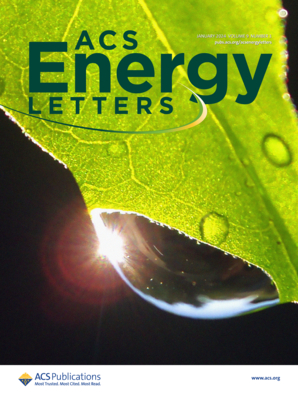水电池金属氧化物中质子插入耦合电子转移(PICET)的基本原理
IF 18.2
1区 材料科学
Q1 CHEMISTRY, PHYSICAL
引用次数: 0
摘要
电网规模应用对可持续和低成本能源存储的需求激发了对新型水性可充电电池的研究。在这种情况下,质子插入耦合电子转移(PICET)到过渡金属氧化物电极中,在高导电性电解质中利用非金属载流子,呈现出一种有吸引力的电荷存储机制。本综述的目的是介绍PICET从中性或酸性电解质转化为过渡金属氧化物的基本原理,因为它与水性可充电电池有关。详细介绍了PICET的电化学特性和过渡金属氧化物载体的选择,PICET的电化学热力学和动力学,以及氢化过渡金属氧化物的性质。特别强调的是用于PICET的水电解质的组成和性质,这影响了电荷存储机制的动力学和热力学。最后,我们讨论了利用过渡金属氧化物电极的质子基水电池的实际考虑和前景。本文章由计算机程序翻译,如有差异,请以英文原文为准。

Fundamentals of Proton-Insertion Coupled Electron Transfer (PICET) in Metal Oxides for Aqueous Batteries
The need for sustainable and low-cost energy storage for grid-scale applications motivates research into new types of aqueous rechargeable batteries. Within this context, proton-insertion coupled electron transfer (PICET) into transition metal oxide electrodes presents an attractive charge storage mechanism that utilizes non-metallic charge carriers in high conductivity electrolytes. The purpose of this Review is to present the fundamentals of PICET into transition metal oxides from neutral or acidic electrolytes as it relates to aqueous rechargeable batteries. We elaborate on the electrochemical features of PICET and the choice of transition metal oxide hosts, the electrochemical thermodynamics and kinetics of PICET, and the properties of hydrogenated transition metal oxides. A particular emphasis is placed on the composition and properties of the aqueous electrolyte used for PICET, which influences the kinetics and thermodynamics of the charge storage mechanism. Finally, we conclude with a discussion of the practical considerations and outlook for proton-based aqueous batteries utilizing transition metal oxide electrodes.
求助全文
通过发布文献求助,成功后即可免费获取论文全文。
去求助
来源期刊

ACS Energy Letters
Energy-Renewable Energy, Sustainability and the Environment
CiteScore
31.20
自引率
5.00%
发文量
469
审稿时长
1 months
期刊介绍:
ACS Energy Letters is a monthly journal that publishes papers reporting new scientific advances in energy research. The journal focuses on topics that are of interest to scientists working in the fundamental and applied sciences. Rapid publication is a central criterion for acceptance, and the journal is known for its quick publication times, with an average of 4-6 weeks from submission to web publication in As Soon As Publishable format.
ACS Energy Letters is ranked as the number one journal in the Web of Science Electrochemistry category. It also ranks within the top 10 journals for Physical Chemistry, Energy & Fuels, and Nanoscience & Nanotechnology.
The journal offers several types of articles, including Letters, Energy Express, Perspectives, Reviews, Editorials, Viewpoints and Energy Focus. Additionally, authors have the option to submit videos that summarize or support the information presented in a Perspective or Review article, which can be highlighted on the journal's website. ACS Energy Letters is abstracted and indexed in Chemical Abstracts Service/SciFinder, EBSCO-summon, PubMed, Web of Science, Scopus and Portico.
 求助内容:
求助内容: 应助结果提醒方式:
应助结果提醒方式:


